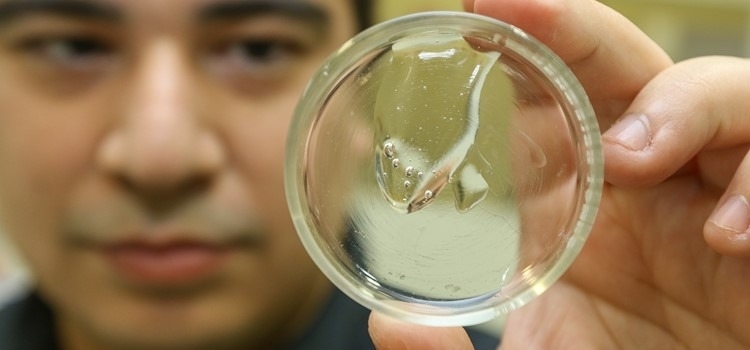

A sprayable solution developed by researchers at the State University of Campinas does not spread rapidly over a surface and efficiently eliminates harmful microorganisms. The technology can be licensed from the university’s innovation agency (photo: Pedro Amatuzzi/INOVA UNICAMP)
A sprayable solution developed by researchers at the State University of Campinas does not spread rapidly over a surface and efficiently eliminates harmful microorganisms. The technology can be licensed from the university’s innovation agency.
A sprayable solution developed by researchers at the State University of Campinas does not spread rapidly over a surface and efficiently eliminates harmful microorganisms. The technology can be licensed from the university’s innovation agency.

A sprayable solution developed by researchers at the State University of Campinas does not spread rapidly over a surface and efficiently eliminates harmful microorganisms. The technology can be licensed from the university’s innovation agency (photo: Pedro Amatuzzi/INOVA UNICAMP)
Agência FAPESP* – Researchers at the State University of Campinas (UNICAMP) in São Paulo state, Brazil, have developed a disinfectant in aqueous form that gellifies as soon as it comes into contact with a surface. It more effectively eliminates microorganisms by not spreading rapidly over the material but remaining where it is applied and seeping into cracks, crevices, pores and grooves that a highly viscous formulation would not enter.
“The aim of the project was to develop a disinfectant with high bactericidal power that could be applied in aqueous form and would instantly react to form a gel. It was also to be less toxic and corrosive in its composition than other cleaning products,” said Edvaldo Sabadini, a professor at the Chemistry Institute (IQ-UNICAMP).
The invention, Sabadini explained, is based on one of the fundamentals of chemistry. “The same mechanism that led to the formation of membranes in the most primitive organisms at the origin of life, known as the ‘hydrophobic effect’, promotes the formation of a bactericidal gel,” he said. The phenomenon in question involves the creation of giant micelles or long molecular aggregates.
The research was supported by FAPESP as part of the Thematic Project “Organizing matter: colloids formed by association of surfactants, polymers and nanoparticles”.
The novel formulation contains two compounds widely known on the market for their bactericidal power and used in mouthwashes and oral rinses: cetylpyridinium chloride and thymol. “The bactericidal action of cetylpyridinium and thymol has been reported in the literature for a long time. We believed these two bactericidal substances had all the structural characteristics needed for the formation of giant micelles in water,” Sabadini said.
Phase transition
Hydrogels form when two substances dissolved in water but kept in separate compartments are combined in a spray. Each substance in isolation has the same viscosity as water, but they rapidly form a gel when combined. The mesh thus formed can imprison a large amount of water, guaranteeing the characteristics of the bactericidal gel.
An interesting aspect of the invention, and one that could spark innovation in cleaning products, is the viscosity of the gel, which can easily be adjusted by varying the concentration and proportions of the two components. More consistent gels can be obtained by using a high concentration of giant micelles to form more of these “molecular noodles” and make them intertwine more tightly.
“When you combine these two ingredients, besides producing the gel, you create synergy in respect of bactericidal power,” Sabadini said. Laboratory tests showed the product to be especially effective against a species of Salmonella that causes recurring infections on hog farms.
Applications
According to Sabadini, the gelling disinfectant can be used to clean surfaces of various materials, including metal, plastic, glass, wood and ceramic tiles. It is particularly effective on porous and sloping surfaces where it needs to remain for some time without running off.
“A bactericidal gel can be made by including a polymer in a bactericidal formulation, but in that case, the gel may fail to reach restricted areas because of its viscosity. Our invention is different because the two liquids aren’t viscous while separate, and viscosity increases only when they come into contact. It covers porous surfaces completely and disinfects them thoroughly,” he said.
The invention’s proposed formulation contains no sodium hypochlorite and is an alternative to many of the cleaning products available on the market. The compound lacks drawbacks such as microbial or chemical degradation of the active ingredient.
The bactericidal gel lacks corrosive properties and so will not damage equipment. The micelles act without attacking the structure they are cleaning. The product is also easily washed off with water. Dilution instantly breaks up the giant micelles, and their components are removed without difficulty.
Technology transfer
The originality of this research and the potential for industrial application of the antimicrobial composition led INOVA UNICAMP, the university’s innovation agency, to file an application for intellectual property protection with the INPI, Brazil’s patent office. The technology is now part of the university’s patent portfolio and is available for licensing.
Companies and public or private institutions interested in transferring technology for innovative processes or products can directly contact INOVA UNICAMP using a form available on the agency’s website for connecting research with the market. Besides providing access to cutting-edge technology, technology transfer reduces the risks associated with the development of innovative processes and products, while also contributing to social and economic development based on scientific knowledge.
* With information from INOVA UNICAMP.
Republish
The Agency FAPESP licenses news via Creative Commons (CC-BY-NC-ND) so that they can be republished free of charge and in a simple way by other digital or printed vehicles. Agência FAPESP must be credited as the source of the content being republished and the name of the reporter (if any) must be attributed. Using the HMTL button below allows compliance with these rules, detailed in Digital Republishing Policy FAPESP.





